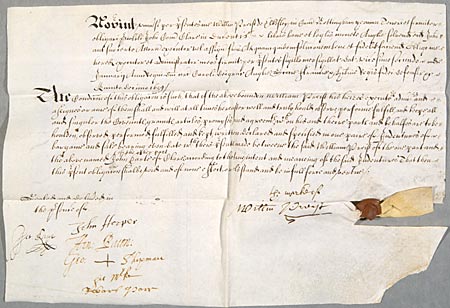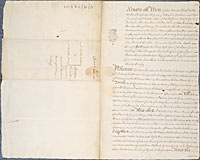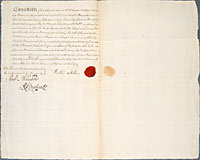Bond
Agreement between two people to pay a financial penalty if certain conditions or actions are not performed.
Features of abond
- medieval - 19th century
- usually written on parchment until c.17th century; usually paper afterwards
- in two parts
- first part written in Latin until 1733
- deed poll (straight top edge)
- seal
Important words and phrases
The person binding himself is called the 'obligor'. The person to whom he is bound is called the 'obligee'.
Bonds are always made up of two parts:
- The 'obligation'. In the obligation, the names of the parties are given, the obligor states that he is bound to the obligee, the penal sum is given, and the date. This part of a bond was in Latin until 1733, except during the Commonwealth period in the mid-seventeenth century when it was in English
- The 'condition'. This part of a bond gives the details of what the obligor is promising to do. At the end, a clause states that if he does what he promises, the bond will become null and void. If he does not, then it will remain in force and he becomes liable to pay the penal sum. This part of a bond was normally in English, even in the medieval period
Early bonds usually had the obligation on one side and the condition on the other side, but by the seventeenth century the two parts were written on the same side, one above the other.
The key words to look out for are
[Latin] Noverint universi per presentes ... teneri et firmiter obligari
[English] Know all men by these presents ... am held and firmly bound
There are three common types of bond:
1) Bond for Debt. These bonds secured the repayment of a sum of money. The penal sum was usually twice the sum which was owed. Bonds for debt were often drawn up in connection with a mortgage and were used to strengthen the covenants for repayment in the mortgage deed. Other bonds for debt might refer to the payment of an annuity, or simply a sum of money lent privately between two people. The words to look out for here are:
if the within bounden AB shall pay or cause to be paid ... the sum of ... with lawful interest...
2) Bond for Performance of Covenants. These bonds were connected with another deed drawn up on the same date, and were used to make sure that the covenants referred to in the deed were kept to - for instance, building a house to a particular specification, or producing title deeds on request. The covenants themselves are not repeated in the bond, so the deed needs to be present in order to make sense of this type of bond. The operative words are:
if the within bounded AB shall keep and perform the several covenants ...
3) Bond for Quiet Possession. These bonds were also connected with other deeds, especially conveyances or leases. They strengthened the warranty clause in the deed to make sure that the new owner or tenant was not subjected to any disturbance. The operative words here are:
if the within bounden AB shall have and peaceably enjoy...
Other types of bond were drawn up for specific occasions. For instance, a group of people might enter into a bond to observe the terms of an arbitration. In the archive of the Archdeaconry of Nottingham there are many examples of marriage bonds. Bondsmen bound themselves to the Archdeacon to ensure that marriages took place at approved locations and times and according to the marriage laws.
Examples
Ne D 1567 - Bond (Latin and English) from William Priest to John Holles, 2nd Earl of Clare for the performance of covenants; 22 Jan. 1640

View this deed
View a line-by-line breakdown of the obligation section of this deed
Transcription:
[line 1] Nov[er]int uniu[er]si per p[re]sentes me Will[ielmu]m Preist de Elkesley in Com[itatu] Nottingham yeoman Teneri et firmiter
[line 2] obligari p[ro]nobili Joh[an]i Com[iti] Clare in ducentis libris bone et leg[a]lis monete Anglie solvend[is] eid[em] Joh[an]i
[line 3] aut suo certo Attorn[ato] executor[ibus] vel assign[atis] suis Ad quam quidem soluc[i]onem bene et fidelit[er] faciend[am] Obligo me &
[line 4] hered[es] executor[es] et administrator[es] meos firmit[er] per p[re]sentes sigillo meo sigillat[um] dat[um] vicesimo secundo die
[line 5] Januarij Anno Regni d[omi]ni n[ost]ri Caroli dei grac[ia] Anglie Scocie Francie & Hib[er]nie Regis fidei defensor &c
[line 6] Quinto decimo 1639.
Translation of the obligation:
[line 1] Know all Men by these presents that I William Preist of Elkesley in the County of Nottingham yeoman am held and firmly
[line 2] bound to the noble John, Earl of Clare, in two hundred pounds of good and lawful money of England to be paid to the said John
[line 3] or his certain Attorney executors or assigns. To which payment, indeed, well and truly to be made, I bind myself my
[line 4] heirs executors and administrators firmly by these presents sealed with my seal. Dated the twenty second day of
[lines 5-6] January in the fifteenth year of the reign of our lord Charles by the grace of god King of England Scotland France and Ireland, defender of the faith &c. 1639
The Condic[i]on of this obligac[i]on is such that if the above bounden William Preist his heires executo[res] admi[nistrators] and assignes or anie of them shall and will at all times hereafter well and truly hould observe performe fulfill and keepe all and singuler the Coven[a]nt[es], graunt[es], articles, promyses, and agreement[es] w[hi]ch on his and theire part[es] and behalfes are to be houlden, observed, performed, fulfilled, and kept, written declared and specified in one paire of Indentures of bargaine and sale bearing even date w[i]th theis p[re]sent[es] made betweene the said William Preist of the one part and the above named John Earle of Clare of the other part according to the true intent and meaneing of the said Indentures That then this p[re]sent obligac[i]on shalbe void and of none effect, or els stand and be in full force and vertue.
The marke of Willm Preist
Sealed and deliu[er]ed in the p[re]sence of
[signatures or marks of John Hooper, Pet. Lane, Hen. Bacon, Geo. Shipman and Robart Parr]
Ne 6 D 2/31/11 - Bond from Walter Meller to Matthew Marr for the quiet enjoyment of Howgates Closes, East Markham, Nottinghamshire; 6 Apr. 1795


View this deed: front | back
Transcription:
Know all Men by these Presents That I Walter Meller of Tuxford in the County of Nottingham Gentleman am held and firmly bound to Matthew Marr of East Retford in the said County of Nottingham Brickmaker in the Penal Sum of One hundred Pounds of Lawful Money of Great Britain to be Paid to the said Matthew Marr or his certain Attorney Executors Administrators or Assigns for which Payment well and truly to be made I bind myself my Heirs Executors and Administrators firmly by these Presents Sealed with my Seal Dated this Sixth Day of April - In the Thirty Fifth Year of the Reign of our Sovereign Lord George the Third by the Grace of God of Great Britain France and Ireland King Defender of the faith and so forth and in the Year of our Lord One thousand Seven hundred and Ninety Five.
Whereas the above Bounden Walter Meller by Indentures of Lease and Release the Lease bearing date the Day next before the Indenture of Release and the Release bearing Even date with these Presents Hath for the Consideration in the said Deed of Release mentioned Granted Bargained Sold Aliened Released and Confirmed unto the above Names Matthew Marr and his Heirs and Assigns for Ever All that Close or Parcel of Inclosed Meadow or Pasture Ground lying and being in East Markham in the said County of Nottingham called or known by the Name of the Howgates Close containing by Estimation Three Acres (be the same more or less) And also all that other Close Piece or Parcel of Inclosed Ground situate lying and being at East Markham aforesaid and also called or known by the Name of Howgates Close containing by Estimation Six Acres and Six Perches (be the same more or less) and which said Two last Mentioned Closes are now in the Tenure or Occupation of the said Walter Meller Together with all and Singular the Hedges Ditches Fences Trees Woods Underwood Waters Watercourses Profits Priviledges and Appurtenances whatsoever to the said Closes and Parcels of Inclosed Ground belonging or in any Wise Appertaining And therein Particularly mentioned as by Reference being thereto had will more fully and at Large appear Now the [page 2] Condition of this Obligation is such that if the said Matthew Marr his Heirs and Assigns shall and do at all times hereafter Peaceably and Quietly have hold Occupy Possess and Enjoy the said Two Closes or Parcels of Inclosed Ground and other the Premises Granted and Released as aforesaid and receive and take the rents Issues and Profits thereof without any Let Suit Trouble Claim or Demand of or by Mary the Wife of the said Walter Meller or any other Person or Persons by or through her means Act Privity Right or Procurement for or in respect of the Dower or Thirds right or Title of Dower of Thirds at the Common Law of England or other right Claim or Demand whatsoever which the said Mary his Wife shall or may have or Claim of in to or out of all and Singular the said Premises Granted and Released as aforesaid Then this Obligation to be Void and of None Effect or Else to remain in full force and Virtue.
[Signature of Walter Meller]
Sealed and Delivered (being first Duly Stamped) In the Presence of
[Signatures of Robt Allwood and R.A. Drabwell]
Next page: Recognizance in the nature of a Statute Merchant